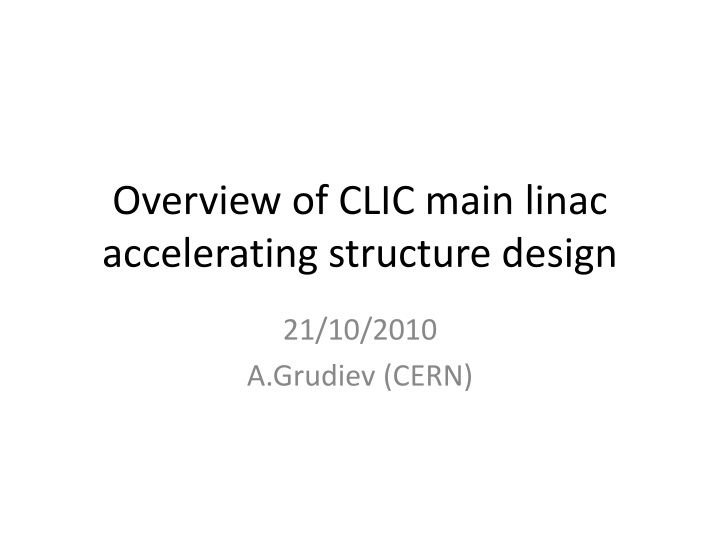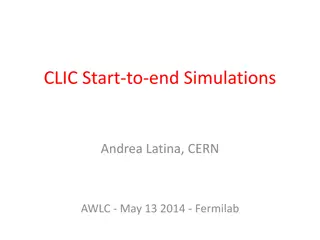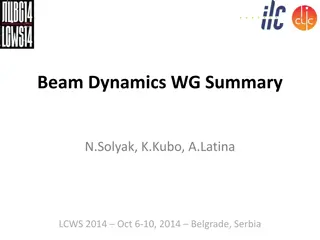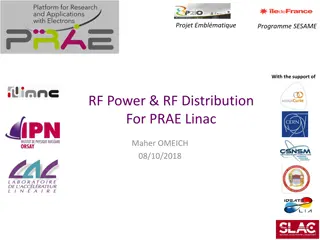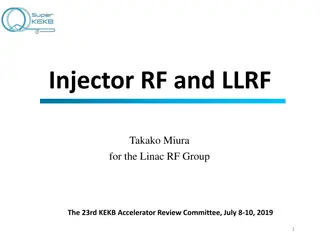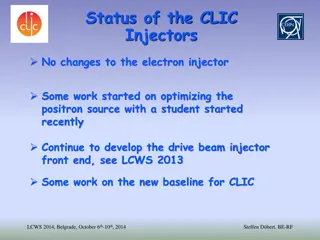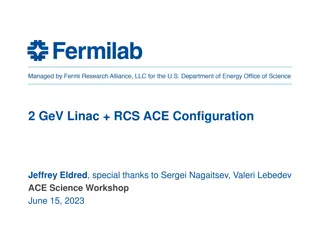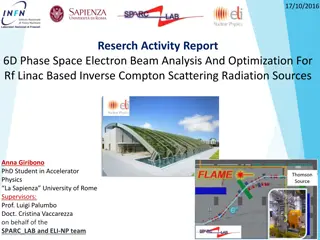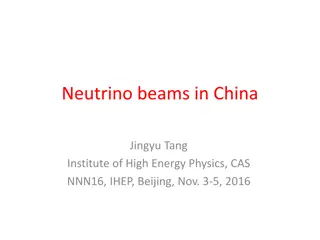Overview of CLIC Main Linac Accelerating Structure Design
Detailed discussion on the RF design constraints, beam dynamics, and structure optimization for the CLIC main linac accelerating structure. The analysis covers parameters such as bunch population, wake suppression, RF breakdown, and surface heating constraints. Additionally, the first generation of CLIC X-band test structure prototypes and their performance are examined.
Download Presentation

Please find below an Image/Link to download the presentation.
The content on the website is provided AS IS for your information and personal use only. It may not be sold, licensed, or shared on other websites without obtaining consent from the author.If you encounter any issues during the download, it is possible that the publisher has removed the file from their server.
You are allowed to download the files provided on this website for personal or commercial use, subject to the condition that they are used lawfully. All files are the property of their respective owners.
The content on the website is provided AS IS for your information and personal use only. It may not be sold, licensed, or shared on other websites without obtaining consent from the author.
E N D
Presentation Transcript
Overview of CLIC main linac accelerating structure design 21/10/2010 A.Grudiev (CERN)
RF design constraints for CLIC C L I C C L I C Beam dynamics (BD) constraints based on the simulation of the main linac, BDS and beam-beam collision at the IP: N bunch population depends on <a>/ , a/<a> because of short- range wakes Ns bunch separation depends on the long-range dipole wake suppression RF breakdown and pulsed surface heating (PSH) constraints: Tmax(Hsurfmax, tp) < 56 K (accelerating structure life time issues) Esurfmax < 250 MV/m Pin/Cin (tp)1/3 < 18 MW/mm ns1/3 (Sc = Re{S} + Im{S}/6) (tp)1/3 < 4 MW/mm2 (200 ns)1/3 CLIC-ACE, 16 Jan. 2008 Alexej Grudiev, Structure optimization.
RF constraints: data analysis 1 dphi [deg] vg1 [%] 120 120 120 150 150 150 150 150 150 60 120 120 120 120 120 120 120 120 180 180 180 180 120 90 60 60 60 150 150 120 RF design name DDS1 T53VG5R T53VG3MC H90VG3 H60VG3 H60VG3R18 H60VG3R17 H75VG4R18 H60VG4R17 10 HDX11-Cu 11 CLIC-X-band 12 T18VG2.6-In 13 T18VG2.6-Out 14 T18VG2.6-Rev 15 T26VG3-In 16 T26VG3-Out 17 TD18_KEK_In 18 TD18_KEK_Out 19 SW20A3p75 20 SW1A5p65T4p6 21 SW1A3p75T2p6 22 SW1A3p75T1p66 23 2pi/3 24 pi/2 25 HDS60-In 26 HDS60-Out 27 HDS60-Rev 28 HDS4Th 29 HDS4Th 30 PETS9mm f [GHz] 11.424 11.424 11.424 11.424 11.424 11.424 11.424 11.424 11.424 11.424 11.424 11.424 11.424 11.424 11.424 11.424 11.424 11.424 11.424 11.424 11.424 11.424 29.985 29.985 29.985 29.985 29.985 29.985 29.985 29.985 High power test results has been scaled to tp=200 ns BDR=1e-6 bpp/m using power scaling lower 1 2 3 4 5 6 7 8 9 11.7 5 3.3 3 2.8 3.3 3.6 4 4.5 5.1 1.1 2.6 1.03 1.03 3.3 1.65 2.4 0.9 30 5 E t a p = const BDR based on the fitting the data 0 0 0 0 4.7 7.4 8 5.1 5.1 2.6 2.6 39.8 3
RF constraints: data analysis 2 Data has been scaled to tp=200 ns BDR=1e-6 bpp/m S + 6 Im S = Re / c S 4
1st generation of CLIC X-band test structure prototypes T18/TD18 Parameters at tp=100 ns, <Ea>=100 MV/m 2007 T18_vg2.6_disk: TD18_vg2.4_disk: 250 250 232 4.4 load = 53.0 MW, Pout load = 37.4 MW 234 4.5 load = 56.8 MW, Pout load = 33.8 MW Pin Eff = 0.0 % tr = 0.0 ns, tf = 0.0 ns, tp = 100.0 ns Pin Eff = 0.0 % tr = 0.0 ns, tf = 0.0 ns, tp = 100.0 ns P [MW] (black), Es (green), Ea (red) [MV/m], P [MW] (black), Es (green), Ea (red) [MV/m], T [K] (blue), Sc*50 [MW/mm2] (magenta) T [K] (blue), Sc*50 [MW/mm2] (magenta) 200 200 3.3 157 148 2.7 150 150 High surface fields 126 120 100 100 79 76 56.8 53.0 49.4 33.8 50 50 37.4 30.6 12.5 8.1 0 0 0 2 4 6 8 10 12 14 16 18 0 2 4 6 8 10 12 14 16 18 iris number iris number Very strong tapering inspired by the idea of having constant P/C along the structure In TD18, all quantities are close to T18 at the same average gradient, except for the pulsed surface heating temperature rise which is factor 5 higher in the last cell. 5
2nd generation of CLIC X-band test structure prototypes T24/TD24 Parameters at tp=100 ns, <Ea>=100 MV/m 2007 TD24_vg1.8_disk: T24_vg1.8_disk: 250 250 load = 41.1 MW, Pout load = 23.4 MW Pin Eff = 0.0 % tr = 0.0 ns, tf = 0.0 ns, tp = 100.0 ns P [MW] (black), Es (green), Ea (red) [MV/m], P [MW] (black), Es (green), Ea (red) [MV/m], 205 T [K] (blue), Sc*50 [MW/mm2] (magenta) T [K] (blue), Sc*50 [MW/mm2] (magenta) 200 193 200 183 3.5 176 3.2 load = 44.4 MW, Pout load = 20.6 MW Pin Eff = 0.0 % tr = 0.0 ns, tf = 0.0 ns, tp = 100.0 ns 3.0 3.0 150 150 108 102 100 100 94 90 50 50 44.4 41.1 26.8 25.1 23.4 20.6 8.4 7.5 0 0 0 4 8 12 16 20 24 24 0 5 10 iris number 15 20 iris number Weaker tapering (quasi const gradient) together with smaller aperture (11% instead of 12.8%) reduce surface fields significantly compared to T18/TD18. In TD24, all quantities are lower than in TD18 at the same average gradient. In particular pulsed surface heating temperature rise reduced by factor 2. 6
Synthesis of accelerating structure test results scaled to CLIC breakdown rate 1400 T18 by KEK/SLAC at SLAC #1 3900 T18 by KEK/SLAC at KEK Total testing time [hr] T18 by KEK/SLAC at SLAC #2 280 T18 by CERN at SLAC 550 TD18 by KEK/SLAC at SLAC HOM damping 1300 TD18 by KEK/SLAC at KEK HOM damping 3200 T24 by KEK/SLAC at SLAC 200 60 70 80 90 100 110 unloaded gradient [MV/m] Scaling to CLIC conditions: Scaled from lowest measured BDR to BDR=4*10-7 and =180 ns (CLIC flat-top is 170 ns), using standard E29 5/BDR=const. Correction to compensate for beam loading not included expected to be less than about 7%. IWLC2010 Walter Wuensch 19 October 2010
Comparison at tp=252 ns, BDR=1e-6 bpp/m T18: <Ea> = 101 MW/m TD18: <Ea> = 86.6 MW/m TD18--KEK, tp = 252 ns, BDR = 1e-6 bpp/m, <Ea. = 86.6 MV/m T18--KEK, tp=252 ns, BDR = 1e-5 bpp/m, <Ea> = 101 MV/m, 250 250 235 4.5 load = 54.1 MW, Pout load = 38.2 MW load = 42.6 MW, Pout load = 25.4 MW Pin Eff = 0.0 % tr = 0.0 ns, tf = 0.0 ns, tp = 252.0 ns Pin Eff = 0.0 % tr = 0.0 ns, tf = 0.0 ns, tp = 252.0 ns P [MW] (black), Es (green), Ea (red) [MV/m], P [MW] (black), Es (green), Ea (red) [MV/m], 202 T [K] (blue), Sc*50 [MW/mm2] (magenta) T [K] (blue), Sc*50 [MW/mm2] (magenta) 200 200 3.3 149 2.7 150 150 136 2.5 127 104 100 100 76 68 59.0 54.1 50 50 42.6 38.2 36.5 25.4 20.3 13.1 0 0 0 2 4 6 8 10 12 14 16 18 0 2 4 6 8 10 12 14 16 18 iris number iris number P/C*tp^(1/3) = 13.4 [MW/mm*ns^(1/3)] P/C*tp^(1/3) = 10.6 [MW/mm*ns^(1/3)] In TD18, all quantities are lower than in T18 measured at the same tp and BDR, except for the pulsed surface heating temperature rise which is factor 3 higher ??? 9
Comparing last cell at tp=252 ns, BDR=1e-6 bpp/m T18: <Ea> = 101 MW/m, Ea = 127 MV/m TD18: <Ea> = 86.6 MW/m; Ea = 104 MV/m 10
Near term plans TD24_vg1.8_disk: TD18_vg2.4_disk: 250 250 234 4.5 load = 56.8 MW, Pout load = 33.8 MW At 11.424 GHz testing of T24/TD24 should come this year. Pin Eff = 0.0 % tr = 0.0 ns, tf = 0.0 ns, tp = 100.0 ns P [MW] (black), Es (green), Ea (red) [MV/m], P [MW] (black), Es (green), Ea (red) [MV/m], T [K] (blue), Sc*50 [MW/mm2] (magenta) T [K] (blue), Sc*50 [MW/mm2] (magenta) 200 200 193 183 3.5 3.3 157 load = 44.4 MW, Pout load = 20.6 MW Pin Eff = 0.0 % tr = 0.0 ns, tf = 0.0 ns, tp = 100.0 ns 3.0 150 150 120 Very interesting because TD24 has 2 times lower PSH T than TD18 102 100 100 94 79 56.8 49.4 33.8 50 50 44.4 30.6 26.8 25.1 20.6 0 0 0 5 10 iris number 15 20 0 2 4 6 8 10 12 14 16 18 iris number TD24_vg1.8_disk TD24_vg1.8_R05: 250 250 load = 40.7 MW, Pout load = 18.6 MW Pin Eff = 0.0 % tr = 0.0 ns, tf = 0.0 ns, tp = 100.0 ns P [MW] (black), Es (green), Ea (red) [MV/m], T [K] (blue), Sc*50 [MW/mm2] (magenta) At 11.994 GHz testing of T24/TD24/TD24_R05 are planed for the next year. P [MW] (black), Es (green), Ea (red) [MV/m], T [K] (blue), Sc*50 [MW/mm2] (magenta) 200 200 194 193 184 3.7 184 3.7 3.1 load = 40.5 MW, Pout load = 18.7 MW 3.1 Pin Eff = 0.0 % tr = 0.0 ns, tf = 0.0 ns, tp = 100.0 ns 150 150 TD24 TD24_R05 provides further reduction of PSH T by 1/3 102 102 94 94 100 100 50 50 40.7 40.5 27.7 26.9 21.1 19.0 18.7 18.6 0 0 0 5 10 iris number 15 20 0 5 10 iris number 15 20 11
Geometry difference between TD24_vg1.8_disk TD24_vg1.8_R05 12
Design of the HOM Damping Load Will be used for CLIC module prototype and for a structure prototype for high power testing with damping load inside (TD24_vg1.8_R05_SiC) SiC properties from M.Luong, 1999 XY Plot 1 Ansoft Corporation f0_45_adw11mm 6000.00 5500.00 5000.00 Y1 4500.00 4000.00 Tip size 1x1 mm Tip length 20 mm or 30 mm Base size 5.6 x 5 or 5.5 mm Base length 10 mm Waveguide width awd = 10.1 mm or 11 mm Curve Info Q(1) thick line: awg = 11mm, thin line: awg = 10.1 mm Setup1 : LastAdaptive Q(1)1 3500.00 Imported 3000.00 50.00 60.00 70.00 80.00 sdw [mm] 90.00 100.00 110.00 13
Design of the damped compact coupler Will be used for CLIC module prototype and for a structure prototype for high power testing with damped compact coupler (TD26_vg1.8_R05_CC) 14
Beyond CLIC_G Next step in rf design will be a structure with a degree of tapering lower than TD18 (41%) and TD24 (8%) For example, ~ 20-25 % It will probably have bigger average aperture if CLIC main beam bunch charge can be increased accordingly. A detailed optimization of the parameters and rf design will be done soon TD18 vg2.4 disk TD24 vg1.7 disk 250 250 226 4.4 200 200 193 183 3.2 3.3 150 155 2.9 150 120 41% 102 8% 100 100 94 79 57.5 47.0 50 44.4 50 29.1 34.3 24.6 20.6 21.7 0 0 0 5 10 15 20 0 5 10 iris number 15 20 25 iris number 15
Quadrants/halves family HALVES Here T18_vg2.6_quad design is used. It has no slots. QUADs with SLOTS T18_vg2.6_quad design is used but rounded 4 slots of 0.2 mm are introduced. 16
Symmetrical disk design It has a number of pros and cons: + higher Q higher cost requires axial alignment tuning is more difficult and it is not implement The structure is in the production 17
Alternative damping designs 1. DDS type is underdevelopment at 12 GHz by Cockcroft Institute and Manchester University (R. Jones, A. D Elia, V. Khan). 2. Choke-mode type is under development in collaboration with Tsinghua University (J. Shi) 1. Minimum gap acceptable from the point of view rf breakdowns to be determined using CD10_choke with different gaps: 1mm, 2mm, etc. 2. Damping design of the full structure is under way aiming at full structure prototype high power test 18
Damping simulation with Gdfidl/HFSS Gap 1mm 2mm Good damping for first dipole Mode reflected by the choke, to be studied 40 gap 1mm gap 1.5mm gap 2mm 30 Zy / k /m/mm 20 10 0 -10 0 10 20 30 40 50 60 70 80 90 f / GHz 103 E field, fundamental mode gap 1mm gap 1.5mm gap 2mm 102 Wy / [V/pC/m/mm] 101 100 (Model in HFSS) 10-1 0 0.2 0.4 0.6 0.8 1 1.2 1.4 1.6 1.8 2 E field of a dipole mode that is reflected by the choke s / m Impedance and wakefield simulated in Gdfidl 20
Design of CD-10-Choke CD10-Choke for demonstration RF Design for Gap 1mm, 1.5mm, 2mm Mechanical Design finished for 1mm-gap Qualification disks and bonding test To the production pipeline and High Power testing 21
Damped Detuned Structure Gaussian distribution of cell parameters is chosen in this (CLIC_DDS) structure which causes Wakefield to decay in nearly Gaussian fashion for short time scale (few nsec) Limited number of cells (N=24) in a structure (poor sampling of a Gaussian) means truncation of Gaussian leading to re- coherence of the wake (t=1/ fmin) Re-coherence of the wake is suppressed by moderate damping: Coupling out the HOMs using a waveguide like structure i.e. manifolds running parallel to the accelerating cells Interleaving neighboring frequencies improves wake suppression structure This is a similar technique to that experimentally verified and successful employed for the NLC/JLC program Potential benefits include, reduced pulse temperature heating (In principle true but not for CLIC_DDS_A: pulse heating is greater than CLIC_G), ability to optimally locate loads, built- in beam and structure diagnostic (provides cell to cell alignment) via HOM radiation. Provides a fall-back solution too!
CLIC_DDS_A: Regular disk #1 Section profile and Parameters Table L = t +g b Parameter Value a (mm) 3.8523 t b (mm) 11.0031 Ellipse a t (mm) 3.8884 t/2 Disk cross-section. 1.0203 *t/2 g (mm) 4.3316 Parameters table. 24
CLIC_DDS_A: E-Field profile along the structure 25
